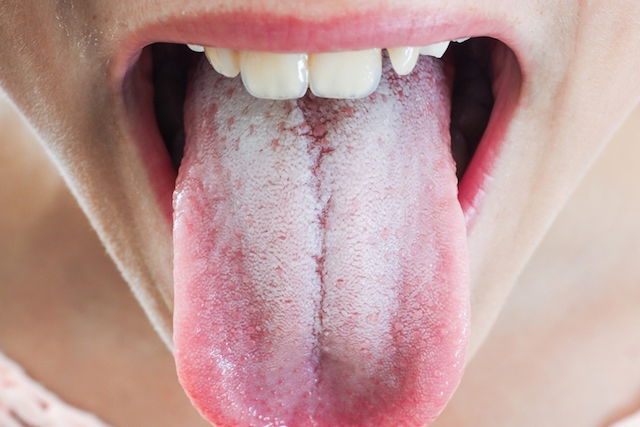A white tongue is usually a sign of excessive bacterial or fungal growth. This can cause dead cells and debris to become lodged between inflamed taste buds, leading to the emergence of white plaques.
This situation is more common in conditions that favor fungal growth, like inadequate oral hygiene or a weakened immune system (like in babies, older adults and people with autoimmune disease).
It is important to see your doctor if you notice a white tongue, so that you can be assessed and appropriate treatment can be initiated.

Why is my tongue white?
The main causes for a white tongue are:
1. Poor oral hygiene
Poor oral hygiene is one of the most common causes for a white tongue. Leaving your teeth unbrushed leads to a greater accumulation of bacteria in your mouth, which can cause enamel damage and lead to the development of oral infections over time.
How to get rid of it: You should brush you teeth at least twice a day and use dental floss to clean between your teeth. You should also ensure to brush your tongue or use a tongue scraper and use mouth wash.
It is also important to keep your mouth hydrated by drinking plenty of fluids every day. You should see your dentist regularly to manage any cavities and for routine teeth cleaning.
2. Oral thrush
Oral thrush is a yeast infection in your mouth that leads to the emergence of white patches in the mouth. It is commonly seen in bed-ridden older adults and babies and occurs due to excessive fungal growth. It can also occur in healthy adults with poor oral hygiene, and in people taking antibiotics or with a history of autoimmune disease, like lupus of HIV.
This fungal infection usually causes symptoms like bad breath, burning in the affected regions, and the sensation of cotton in your mouth.
How to get rid of it: You should perform adequate oral hygiene by brushing your teeth at least twice a day and using a mouth wash to prevent bacterial browth. If symptoms do not improve within a week, you should see your doctor for an oral antifungal, like nystatin.
3. Lichen planus
Lichen planus is an autoimmune disease that triggers inflammation in the lining of the mouth. It can frequently cause white patches to appear on the tongue or inside of the cheeks, as well as small wounds that look like canker sores. It is also common to feel burning in the mouth and excessive sensitivity to hot, spicy or acidic food.
How to get rid of it: You should see your doctor for assessment. Although there is no single medication available to cure lichen planus, the doctor may prescribe corticosteroids like triamcinolone to relieve inflammation and pain. In addition, you should use a toothpaste that does not contain sodium lauryl sulfate, as this can help to prevent symptom worsening.
4. Leukoplakia
This chronic illness causes the appearance of white plaques on the inside of the cheeks, the gums, and in some cases, the tongue. These plaques do not improve with brushing and are generally painless.
Although it is not known what causes this condition, it is most frequently seen in smokers and it may be related to early signs of mouth cancer.
How to get rid of it: If you do not see improvements within 2 weeks, you should see your doctor dentist to evaluate your risk for cancer. If these are benign plaques, the doctor may prescribe antivirals or perform a small procedure to remove the plaques.
5. Syphilis
Syphilis is a sexually-transmitted infection that can affect the mouth during unprotected oral sex. The first symptoms can take up to 3 months to appear, and can emerge as small wounds in the mouth. Learn more about the main symptoms of syphilis and when they typically appear.
How to get rid of it: Treatment is done with a penicillin infection, therefore you should see your doctor for diagnosis. If left untreated, you may notice your symptoms improve after 3 weeks, but the illness will then evolve to its second phase, in which it spreads to the rest of the body.
6. Stomach inflammation
A white tongue can also be triggered by stomach problems, like gastritis. Gastritis is an inflammation of the stomach lining and is often related to a bacterial infection. Common symptoms include stomach pain and burning, nausea and vomiting. Read more about the symptoms of gastritis.
How to get rid of it: In this case, you are advised to see your doctor for a diagnosis to be confirmed and for appropriate treatment to be initiated. Check-out the home remedies for gastritis you can incorporate into your medical treatment.
When to go to the doctor
In most cases, a white tongue is not a sign of a serious illness. It can often be treated at home by brushing your tongue adequately and drinking lots of water.
Nonetheless, if the white tongue lasts for longer than 2 weeks or if you notice symptoms like pain or burning, you should see your doctor to investigate for any disease and start treatment as necessary.
